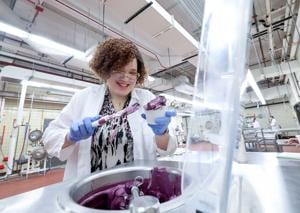Two molds of ice cream sat atop metal mesh balanced over beakers in a warm University of Wisconsin Babcock Hall lab on Monday, an endurance test perfectly suited for the day's stifling heat. The question: Which one would hold its shape the longest, and which one would drip through the wires into milkshake form? UW-Madison Ph.D.
graduate Cameron Wicks scoops a batch of blueberry slow-melting ice cream into containers. Over the last six years of research, Wicks has discovered how infusing polyphenols — compounds found naturally in plants such as blueberries and green tea leaves — slows how quickly ice cream melts by increasing its viscosity. In the UW-Madison basement-level lab, the answer was largely predestined.

One scoop was regular ice cream, not unlike what visitors could buy upstairs at the Babcock Dairy store. The other was a concoction of UW-Madison Ph.D.
researcher Cameron Wicks, in which an addition of polyphenols — compounds naturally occurring in plants such as blueberries and green tea leaves — helps ice cream keep its shape by counteracting melting ice crystals. UW-Madison Ph.D.
graduate Cameron Wicks views the fat cells of a slow-melting ice cream in a Babcock Hall lab. The sample had to be diluted with water to ensure the fat clusters could be seen, since the sheer number of them would be hard to see otherwise. The more polyphenols infused in the ice cream, the better it resisted melting and held its shape for hours.
"It's basically physics and ice cream.























